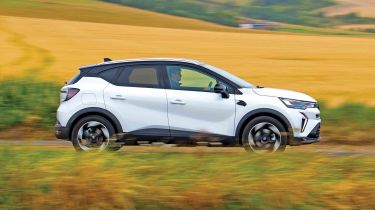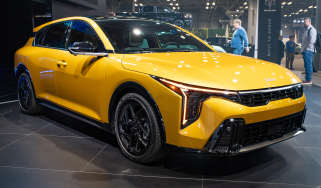Renault Captur - Engines, performance and drive
The Renault Captur offers two options, a slow petrol and a powerful and efficient hybrid

The Renault Captur is offered with a pair of powertrain choices. The first option is easy to explain: it’s a turbocharged 1.0-litre three-cylinder petrol unit that produces a rather modest 89bhp and 160Nm of torque.
However, the other option is much more advanced. The E-Tech full-hybrid model’s internal combustion element is fairly simple – a 1.6-litre four-cylinder petrol engine – but it’s paired with an intriguing hybrid system that makes a combined total of 143bhp and a healthy 250Nm of torque.
The E-Tech system consists of a pair of electric motors, with a more powerful motor capable of driving the car under electric power alone for short distances, and a smaller electric motor that’s used to start the petrol engine, work as a generator to help recharge the 1.2kWh battery, and apply a little torque to the gearbox to make gear changes smoother.
The way it works is different to the hybrid system you’ll find in the Toyota Yaris Cross, which uses a continuously variable transmission (CVT). The Toyota system is smoother overall, but it does have a habit of causing the engine revs to soar when accelerating up to motorway speeds. The Renault system can also be a little raucous when accelerating hard, but it quietens down once up to speed, and isn’t as prone to engine rev flares when overtaking slower-moving traffic as the Yaris Cross. All in all, the E-Tech is much more efficient than a regular petrol automatic small SUV, and it compares favourably with its fellow hybrid rivals for running costs.
| Model | Power | 0-62mph | Top speed |
| Renault Captur TCe 90 | 89bhp | 14.3s | 104mph |
| Renault Captur E-Tech 145 | 143bhp | 10.6s | 106mph |
What is the Renault Captur like to drive?
Comfort is the Captur’s calling card, with the French model delivering a smoother ride than most alternatives in this class. We think that the entry-level 89bhp petrol engine could do with a little more power, though.
In town
When paired with the hybrid powertrain, the Captur always moves off in electric mode, so it’s very smooth and quiet when shuffling about in traffic.
Used - available now

2013 Renault
Captur
34,713 milesAutomaticDiesel1.5L
Cash £10,200
2017 Renault
Captur
43,607 milesAutomaticDiesel1.5L
Cash £9,587
2021 Renault
Captur
16,873 milesAutomaticPetrol1.6L
Cash £15,087
2021 Renault
Captur
18,338 milesManualPetrol1.0L
Cash £12,500The base petrol model is hampered by a spongy clutch pedal, which makes the same low-speed journeys less pleasant. It’s one of our few criticisms, though, because otherwise, the Captur’s decent visibility, light steering and soft ride make it a really pleasing place to be during the slowest, most boring parts of the majority of trips in urban areas.
On A- and B-roads
The soft suspension of the Renault Captur can take more than one bounce to settle if you hit a larger bump, but it generally delivers impressive comfort on the move. You’ll also notice a reasonable amount of body lean in the bends – a feeling that is enhanced by what seems like an SUV-like high centre of gravity – compared with the more agile Ford Puma, but you can still confidently maintain a very satisfying flow along a twisty road in the Captur because there’s plenty of outright grip on offer.
While the hybrid powertrain switches between petrol and electric near-seamlessly around town, if you demand a sudden burst of acceleration at speed, the engine can take a while to wake up, at which point the four-cylinder unit makes a lot of noisy fuss.
On the motorway
At higher speed, the Captur Hybrid easily has what it takes to keep up with traffic. The base petrol model feels much more strained, though, and you really need to use the full travel of that accelerator pedal to make decent progress. Once up to speed, both are impressively comfortable and refined, but we’d like slightly more precise steering to give an added feeling of stability.
Engines, 0-62 acceleration and top speed
High performance is rarely a top priority in this class, but the entry-level 1.0-litre TCe powertrain in the Renault Captur is, without sugar-coating it, slow. With the engine packing a peak power output of only 89bhp, and a lean 160Nm of torque, acceleration is leisurely beyond the sluggish on-paper 0-62mph time of 14.0 seconds. Being a little undernourished, the engine needs to work quite hard to keep up with traffic at high speeds, affecting refinement and economy. The six-speed manual gearbox shifts well, which is good news because you’ll need to use it frequently to make good progress.
The Captur E-Tech largely fixes all these issues, but for a not inconsiderable £3,500 extra. On paper, the hybrid’s 143bhp doesn’t seem much more rapid, but the clever system of electric motors and a four-cylinder petrol engine combine to create a more potent powertrain overall.
The E-Tech hybrid uses a system you’ll find in many Renault cars, and the Nissan Juke, where the petrol engine is aided by a small electric motor – helping it feel torquier and more responsive than its 10.6-second 0-62mph time suggests.
At low speeds, the Captur’s hybrid system largely relies on one or both of its e-motors, keeping the petrol engine dormant up to 80 per cent of the time. This helps reduce fuel consumption by up to 40 per cent on the WLTP urban economy cycle. It’s not a plug-in hybrid, so there’s no need to charge up separately, instead it’s the petrol engine that chimes in when more power is needed, charging the battery simultaneously.
When the engine wakes up, it’s able to drive the front wheels with or without the electric motor, and does so through a four-speed automatic transmission. At high speeds, the petrol engine can sometimes become a little raucous if you ask for full power, as it squeezes all the available power from the four-cylinder engine.








